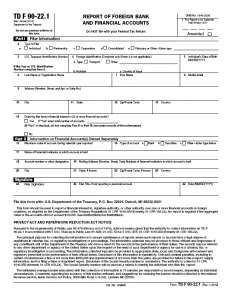
Loading Website ...

Loading Website ...
The following is a general overview of form TDF 90-22.1 which is more commonly referred to as FBAR. The following discussion outlines what an FBAR form is, who needs to file a FBAR as well information on the due date for filing and where the completed FBAR needs to be sent.
A FBAR form is a United States information form that must be filed annually which reports foreign, non-
Who needs to file a FBAR?
Any US person that has a financial interest or signing authority over foreign (non-US) accounts of which the total aggregate balance of the foreign accounts is greater than $10,000 at any point during the year. A US person is defined as a US citizen, US residents and entities including corporations, partnerships or limited liability companies that were created or organized in the US or under laws of the US.
See below for a few of the more common questions people have about FBAR’s
Scenario 1
If an individual had two foreign accounts during a year and one had a maximum balance during the year of $8,000 and a December 31 balance of $6,000, while the second account had a high balance of $5,000 (only for one day) and a year end balance of $500, would they have an obligation to file an FBAR?
Generally speaking, the individual would have an obligation to file a FBAR given that the highest balance is each account during the year was $8,000 (Account 1) and $5,000 (Account 2) for a total of $13,000.
Scenario 2
I have two foreign accounts, a Canadian Chequing account and a Canadian RRSP account. During the year the highest balance in my Chequing account was $6,000 and the highest balance in my RRSP was $4,010. During the year, however, I transferred $3,000 dollars from my Chequing account to my RRSP during the year. Would I still be required to file even if the only reason I was over the 10,000 threshold was because of transfers between two accounts?
Generally, transfers between accounts would be backed out of the calculation of the highest balance during the year. As a result, since the $3,000 transfer would be counted twice, this amount would be backed out leaving you will a highest balance in the Chequing of $3,000 and the highest balance in the RRSP of $4,010. The $7,010 maximum balance would not meet the $10,000 threshold and therefore you would not be required to file an FBAR for that year.
What foreign currency rate should I use to convert my highest balances to US dollars?
The maximum balance during the year in each account should be translated to US dollars at the December 31st exchange rate. Exchange rates can be found on the U.S. Treasury Financial Management Service website http://fms.treas.gov/intn.html.
If I have joint foreign accounts that I hold with my spouse, how do I report these?
Joint accounts are reported on Part III of the FBAR.
When does the FBAR need to be filed?
The FBAR forms must be received by the Treasury Department on or before June 30th of the year following the calendar year that is being reported. For example, you must file the FBAR information relating to account balances for 2011 by June 30, 2012. These forms must be received by the June 30th deadline and there is no extension available past this date.
Where do I send the FBAR? Is it sent in with my 1040 return?
The FBAR is not sent in with the 1040 return. FBAR’s are sent to the Department of the Treasury and if you send the FBAR with your tax return it is very unlikely that it will ever make it to the Department of the Treasury, in which you case you would be deemed not to be in compliance and could be subject to filing penalties.
If, however, you are filing under the new IRS Streamline Program, you will file the TDF 90-22.1 (FBAR) for the most recent six year period with the most recent three year 1040 tax returns. For more information on the IRS Streamline Program, click here.
What are the consequences of failure to file FBAR’s?
Individuals who are required to file a FBAR and fail to comply appropriately could be subject to a penalty of up to $10,000 per violation. If there is reasonable cause for not filing, no penalty may be imposed, however; if it is deemed to be a willful failure to file, the individual could be subject to a penalty equal to the greater of $100,000 or 50% of the balance in the foreign accounts.
Still have questions about your FBAR requirements or other US tax filings requirements? Give Tony Theaker of Hutcheson & Co. a call at 250-381-2400.
The information contained in this article is for general use only and should not be viewed as professional advice. Accounting and tax rules and regulations regularly change and individuals should contact a competent professional to obtain accounting and tax advice based on their specific situation.
Our dynamic Team are always contributing the latest tips and techniques to keep you in the know with all things tax, accounting, and bookkeeping. See more from this author below.

Tony Theaker:
I’ve completed my husband’s FBAR 2014 but have not had any success in submitting it this year. Would you be able to do this from your office. It would naturally have to be re-typed. My husband is 90 years old and blind. He also has mobility issues and would not be able to travel to Victoria. The information on the form is quite simple: four Canadian joint accounts. It would be helpful to know what the charge would be for this service. Thank you.